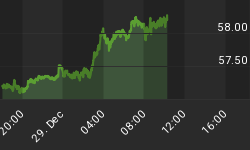Graceland Updates 4am-7am
Apr 30, 2013
-
Recently, many bullish gold analysts have started questioning their own theory that money printing causes inflation.
-
Commodity prices have fallen, despite accelerated QE. I would argue that money printing does cause inflation, but only if what is printed overwhelms the assets that are destroyed, in global markets.
-
The Fed continues to buy billions of dollars of illiquid and arguably-worthless OTC derivatives each month, with printed money. If the Fed printed more money than what is required to purchase those assets, inflation would likely be much higher than what it is now. So far, that's not happening.
-
Quantitative easing is not the same thing as just printing money and pushing it into the banking system.
-
The inventory of marked-to-model OTC derivatives held by commercial banks is gigantic, so it could be many years before serious " cost push" inflation envelops America.
-
The Fed believes in a business cycle that lasts for about 8 years. The last cycle probably ended in 2007, which means that the current upswing could continue to about 2015.
-
From 2015 onwards, the Fed is likely to become much more dovish than they already are, in an attempt to counter a likely downturn in the business cycle.
-
The actions of global central banks, in the 2015-2022 timeframe, are likely to usher in cost push inflation. Clearly, investing in gold requires lots of patience!
-
Please click here now. You are looking at my monthly " big picture" HUI chart. I've lighted the price zones where gold offers value with blue HSR (horizontal support & resistance) lines.
-
Also, note the action of the Stochastics indicator. I call this situation, "Close, but no cigar!" A crossover buy signal for long term investors has not yet been generated, but it's very close.
-
Many bank economists and technical analysts are stating that the current gold rally will fail, and gold will break the lows near $1320. It's hard to know how such a decline would affect gold stocks, but I doubt it would be a positive experience for investors.
-
Put options are like fire insurance; nobody likes to pay the premiums, but if there is a really serious fire , you'll be glad you bought them.
-
If you are afraid that gold could fall and break the $1320 area lows, you may want to consider looking into this type of insurance policy, for your portfolio.
-
Cash is another form of insurance. The gold market is probably many years away from offering a " back up the truck" type of market to investors.
-
I wouldn't be overly concerned about drawdowns (gold is a high quality asset), but some cash should be kept on hand, so you can buy more gold if it goes surprisingly lower.
-
In the short term, gold stocks are grinding higher, but volume is a big concern. Please click here now. That's the GDX daily chart. Some technical analysts see a bearish flag pattern in play.
-
On up days, volume has been stronger than on down days, but the overall pattern is one of declining volume, and that's bearish.
-
My " stokeillator" is highlighted at the bottom of the chart. It suggests that even if gold stocks are " doomed" to make fresh lows, the rally could continue further.
-
Please click here now. This chart provides a closer look at GDX, using 2 hour bars.
-
Note the top of the price gap at about $32. If you were able to buy some stock at lower prices, I would book some profit at $31.90, $33.50, and $35.25.
-
Many physical metal enthusiasts have noted the enormous surge in demand in Asia and at mints around the world, but most bank analysts are projecting lower prices.
-
I think gold needs to consistently trade above $1500 to put some real fear into the bears. So far, that hasn't happened.
-
From the $1590 area highs, gold fell about $270, to the $1320 zone. It's retraced about 60% of that decline now, and Fibonacci traders are probably quite aggressive sellers in the $1480-$1500 area. I suggest very light selling now, and more between $1500 and $1550, if we get there.
-
Gold probably can get over $1500 on this move, but only if both the FOMC meet and Friday's job reports provide more bullish fuel to the " golden race car"!
Special Offer For Website Readers: Please send me an Email to freereports4@gracelandupdates.com and I'll send you my free "What's Up With The Phizz?" report. I discuss why the gold price is stagnant while buyers in Asia line up to buy, and the tactics to use to profit from this bizarre market!
Thanks!
Cheers
St
















